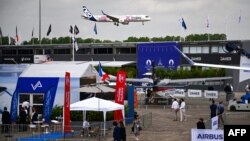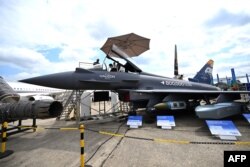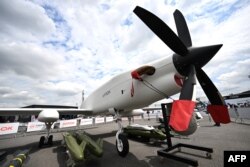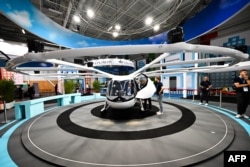Military and civilian aircraft streaked across the sky as the Paris Air Show returned Monday after a four-year COVID-induced hiatus, with a big crowd including Ukrainian military officials and the French president.
Organizers have billed the biennial event as the "recovery airshow" after the coronavirus ravaged the sector and the event was cancelled in 2021.
This year's airshow has a new focus on defense following Russia's invasion of Ukraine, along with the industry's efforts to reduce its carbon footprint, with French President Emmanuel Macron arriving in a helicopter partly using sustainable aviation fuel (SAF).
Huge traffic jams around Le Bourget airport outside Paris were testament to the interest in this year's show, as aircraft makers field hundreds of orders and airlines brace for a near-record number of passengers this year.
The Ukraine conflict has also prompted countries to step up military spending, which could benefit aerospace defense firms.
While Russia has been excluded from the event, Ukrainian military officials toured the huge exhibition space at Paris-Le Bourget airport, some taking photos of missiles on display.
Le Bourget offers a forum to announce deals with some 2,500 firms lining up to show off their latest planes, drones, helicopters and prototypes such as flying taxis.
Airbus chief executive Guillaume Faury, who heads France's aerospace industry association GIFAS, called it "the return of the good old times of the excitement of the show."
Macron was welcomed as he opened the event with an aerial display including Airbus' latest A321 XLR airliner, civilian and military helicopters and a jet fighter.
Businesspeople and uniformed military visitors from around the world watched the action or headed into the guarded private spaces of the major firms' stands.
With 125,000 square meters of exhibition space — the equivalent of nearly 18 soccer pitches — around 320,000 visitors are expected during the week-long event.
Big deals
Along with the Farnborough airshow in England, which takes place in even numbered years, Le Bourget is a key sales event for the civil and defense industries.
Airbus and rival Boeing compete fiercely in announcing orders for aircraft running into the billions of dollars.
Both industry heavyweights are also battling to solidify supply chains as they increase production to meet growing demand.
At least 158 planes, helicopters and drones are on display, from the latest long-haul commercial jets to the F-35, a U.S. stealth fighter.
The United States has a strong presence with 425 exhibitors, bolstered by renewed interest in military equipment in the aftermath of the Ukraine war.
Firms from 46 other nations are present.
China, which lifted COVID restrictions only at the beginning of this year, is also represented.
However, Beijing is not displaying its first homegrown medium-haul passenger jet, the C919, built to compete with the Airbus A320neo and Boeing 737 MAX.
Flying taxis
The airshow also hopes to open a window into the future as projects for flying taxis and other vertical takeoff aircraft abound.
Several prototypes will be on display as part of a "Paris Air Mobility" exhibition to showcase the latest innovations that developers hope will change how people travel.
Engine maker Safran announced early Monday that it would open four production lines in France and Britain making electric motors for small planes.
For his part, Macron arrived aboard Airbus' latest helicopter, the H160, in a flight fueled with 30% SAF before visiting the European group's stand laying out its net-zero-by-2050 plan.
Macron had on Friday announced $2.2 billion to help develop technologies to reduce aircraft emissions.
Air travel accounts for nearly 3% percent of global CO2 emissions but serves only a small minority of the world population.
With the industry targeting net zero emissions by mid-century, firms are turbocharging efforts to achieve it.
The initial focus is on SAF, made from sources such as municipal waste, leftovers from the agricultural and forestry industry, crops and plants, and even hydrogen.
But companies are also working to develop battery- and hydrogen-powered aircraft.








